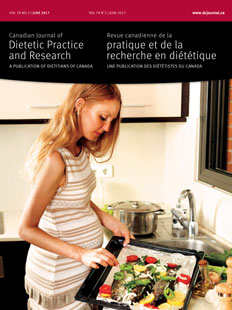Abstract
Purpose: To compare docosahexaenoic acid (DHA), eicosapentaenoic acid (EPA), and fish intake of pregnant women at 30 weeks of gestation to current recommendations and to determine the factors associated with omega-3 (ω-3) intake.
Methods: A food frequency questionnaire was completed by 54 women (54/131 = 41%) at 30 ± 0.8 weeks gestation. Supplement intake, sociodemographic characteristics, and ω-3 food habits were evaluated.
Results: Among this high socioeconomic status (SES) group, 66.7% and 64.8% met the Food and Agriculture Organization of the United Nations (FAO)/World Health Organization (WHO) recommendation of 200 mg/d DHA and 300 mg/d DHA + EPA, respectively, and only 48.1% met the Academy of Nutrition and Dietetics (Academy) recommendation of 500 mg/d DHA + EPA. Eighteen of the 54 women took a ω-3 supplement during the third trimester. This significantly improved their total intake to meet the FAO/WHO (88.9% ≥200 mg/d DHA and 94.4% ≥300 mg/d DHA + EPA) and the Academy (77.8% ≥500 mg/d DHA + EPA) recommendations. Among nonsupplement users (36/54), 50% met the FAO/WHO recommendations and only 33.3% met the Academy recommendations.
Conclusions: Results suggest that the majority of high SES women did not meet ω-3 recommendations from food alone. Continued prenatal education on the importance of fish intake and on the addition of ω-3 prenatal supplement is essential.
Résumé
Objectif : Comparer l’apport en acide docosahexaénoϊque (ADH), acide eicosapentaénoϊque (AEP) et en poisson chez les femmes enceintes à 30 semaines de gestation aux recommandations actuelles et déterminer les facteurs associés avec l’apport en oméga-3 (ω-3).
Méthodes : Un questionnaire de fréquence alimentaire a été complété à 30 ± 0,8 semaines de gestation par 54 femmes (54/131 = 41%). La prise de suppléments, les données socio-démographiques et les habitudes alimentaires ω-3 ont été évaluées.
Résultats : Parmi ce groupe avec un haut statut socio-économique, 66,7 % et 64,8 % ont atteint la recommandation de l’Organisation des Nations Unies pour l’alimentation et l’agriculture (FAO)/Organisation mondiale de la santé (OMS) de 200 mg/j ADH et 300 mg/j ADH + AEP, respectivement, et 48,1 % ont atteint la recommandation de l’Academy of Nutrition and Dietetics (Academy) de 500 mg/j ADH + AEP. Dix-huit des 54 femmes prenaient des suppléments ω-3 au troisième trimestre. Les suppléments ont augmenté leur apport total. Ces 18 femmes ont atteint les recommandations de la FAO/OMS (88,9 % ≥200 mg/j ADH et 94,4 % ≥300 mg/j ADH + AEP) et de l’Academy (77,8 % ≥500 mg/j ADH + AEP). Parmi les non-utilisatrices de supplément (36/54), près de 50 % ont atteint les recommandations de la FAO/OMS et seulement 33,3 % ont atteint la recommandation de l’Academy.
Conclusions : La majorité des femmes n’ont pas atteint les recommandations à partir de l’alimentation seule. L’éducation prénatale concernant l’importance de la consommation en poisson et de l’ajout d’un supplément prénatal ω-3 demeure essentielle.



